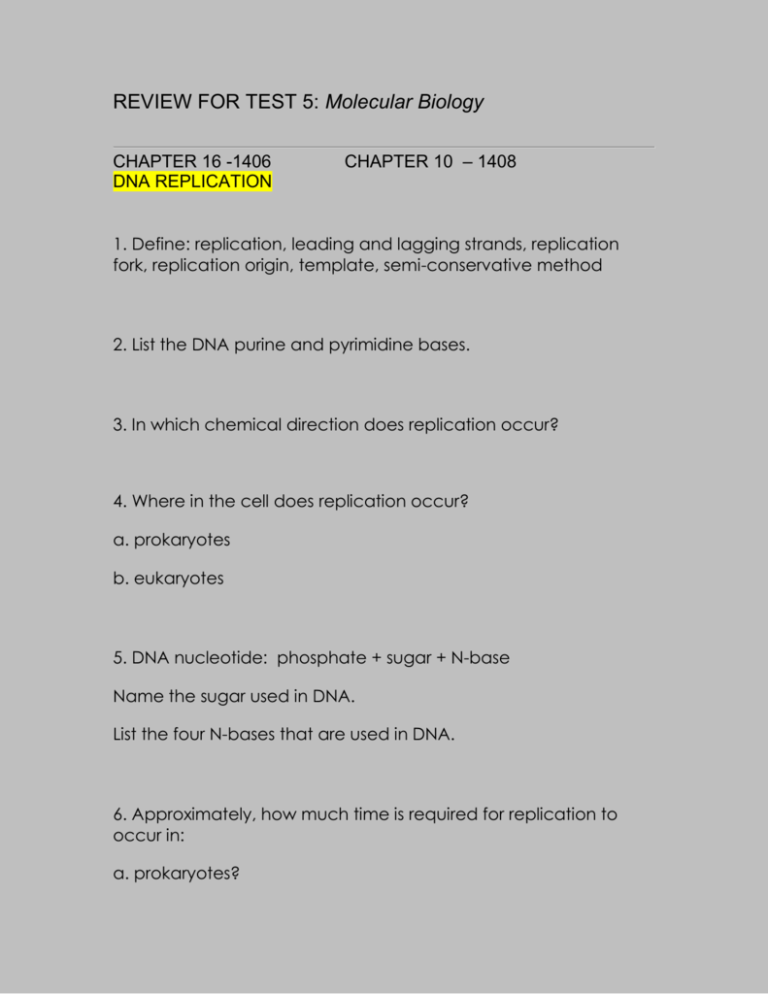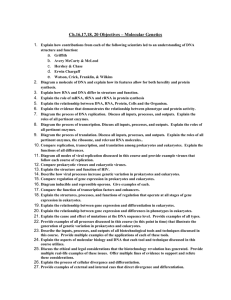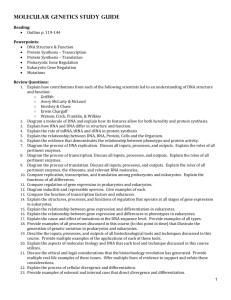REVIEW FOR TEST 5: Molecular Biology
advertisement

REVIEW FOR TEST 5: Molecular Biology CHAPTER 16 -1406 DNA REPLICATION CHAPTER 10 – 1408 1. Define: replication, leading and lagging strands, replication fork, replication origin, template, semi-conservative method 2. List the DNA purine and pyrimidine bases. 3. In which chemical direction does replication occur? 4. Where in the cell does replication occur? a. prokaryotes b. eukaryotes 5. DNA nucleotide: phosphate + sugar + N-base Name the sugar used in DNA. List the four N-bases that are used in DNA. 6. Approximately, how much time is required for replication to occur in: a. prokaryotes? b. eukaryotes? 7. Typically, how many replication origins are formed in: a. prokaryotes? b. eukaryotes? 8. In replication, what do the following enzymes do? a. helicases b. single-strand binding proteins c. DNA polymerases d. DNA ligase 9. What are Okazaki fragments? What is the length (# of nucleotides) of these fragments? What enzyme joins these fragments together? 10. Understand the replication process. 11. Describe work done by: a. Alfred Hershey and Martha Chase on DNA viruses. b. Frederick Griffith with Streptococcus pneumoniae. c. James Watson and Francis Crick. d. Chargaff (Chargaff's rule). e. Rosalind Franklin and Maurice Wilkins 12. Replicate: 5’ ATG 3’ CHAPTER 17 -1406 PROTEIN SYNTHESIS CHAPTER 10 – 1408 1. Define: transcription, reverse transcription, reverse transcriptase, RNA polymerases, codon and anticodon, sense and nonsense codons, terminator and promotor regions, transcription unit, polyribosome 2. List the RNA purine and pyrimidine bases. 3. In which chemical direction do the following occur? a. transcription b. translation 4. Describe the major types of cellular RNA. a. mRNA b. rRNA c. tRNA d. snRNA (in eukaryotes only) 5. List the start codon and the amino acid it codes for. List the three stop (nonsense) codons. 6. Where in the cell do transcription and translation occur in a. prokaryotes b. eukaryotes 7. RNA nucleotide: phosphate + sugar + N-base Name the sugar used in RNA. List the four N-bases that are used in RNA. 8. Before translation occurs in eukaryotic cells, the pre-mRNA must be processed to form the mRNA. Understand the process. What are introns and exons? 9. In the priming process: a. what is a primer? b. what function does primase serve? 10. Why are RNA polymerases considered more versatile than DNA polymerases? 11. Understand the three stages of translation: a. initiation b. elongation c. termination 12. What are the two subunits of a ribosome? 13. Explain the wobble concept. Adenine can be modified into inosine (I) and carried by __RNA. Inosine can bind to ____, ____, or ____. 14. Explain, :redundancy of the code." 15. Transcribe and translate: 5’ ATG 3’ 16. Describe the work done by a. Beadle and Tatum (one gene - one enzyme" hypothesis. Llater restated to read 'one gene one polypeptide' hypothesis) 17. compare: mutation, mutagens, mutagenesis 18. Describe the following ways in which eukaryotes can acquire new genotypes. a. crossing-over b. mutations 19. Describe the following ways in which prokaryotes can acquire new genotypes. a. mutations b. conjugation c. transduction d. transformation 20. Describe the following types of mutations: a. base substitution 1. nonsense mutation 2. missense mutation 3. neutral mutation b. deletion and insertion 1. frameshift mutation CHAPTER 18 -1406 CHAPTER 11 - 1408 REGULATION OF GENE EXPRESSION Chapter 18: The Genetics of Viruses and Bacteria 1. NATURALLY PRODUCED GENETIC RECOMBINATIONS a. Define: transposons, transformation, conjugation, transduction b. Conjugation in bacteria is mediated through ____. Does conjugation require cell-to-cell direct contact? What are sex pili used for? What are F+ and F- cells? c. What carries bacterial DNA from donor to recipient in transduction? Bacteriophages (phages) are viruses that infect only ____. CHAPTER 19 -1406 VIRUSES Cancer CHAPTER 10-1408 1. Define: cancer, carcinogen, tumor, benign and malignant, metastases, transfection, proto-oncogene and oncogene, tumorsupressor genes 2. Approximately how many different types of human cancers are recognized? 3. Human cancers are caused mostly by ____ and some (15%) by ____. 4. List some cancer-affecting voluntary and involuntary behaviors. 5. List some cancer-causing viruses. 6. Outline the two hypothesis on aging. 7. Describe the origins of the following: a. sarcoma b. carcinoma c. leukemias d. lymphomas CHAPTER 20 -1406 BIOTECHNOLOGY CHAPTER 12 – 1408 Artificially produced genetic recombinations 1. Define: genetic engineering, restriction enzymes, recombinant DNA technology, sticky ends and blunt ends, vector, genomic library 2. Describe the stages of genetic engineering. a. cleave DNA b. recombinant DNA c. clone d. screen e. harvest 1. gene 2. protein 3. Be familiar with uses of recombinant DNA technology. 4. Describe the Human Genome Project (http://www.genome.gov/10001772 5. Provide examples of organisms whose genomes have been completely sequenced. Is there a relationship between genome size (bp) and number of genes?








